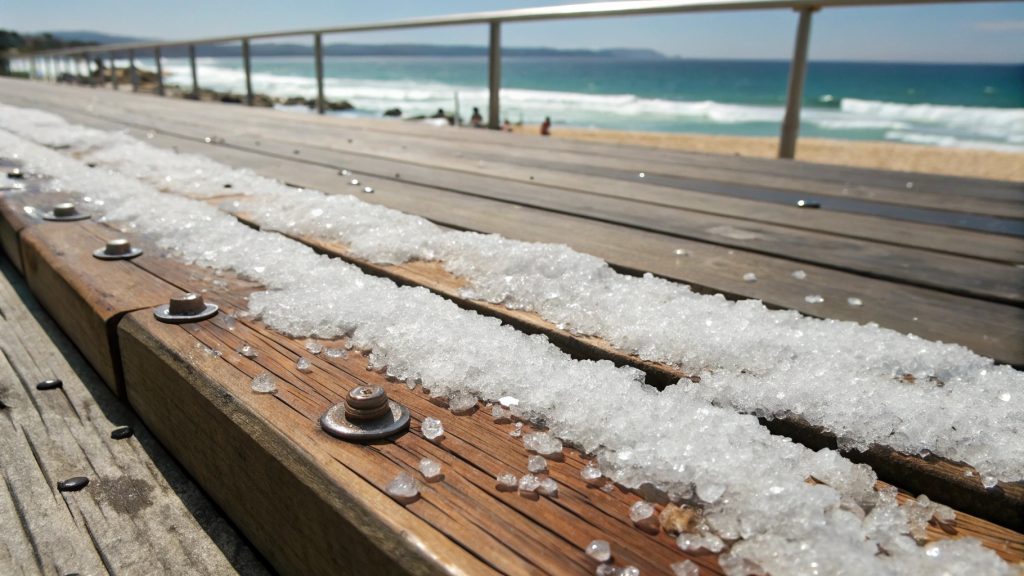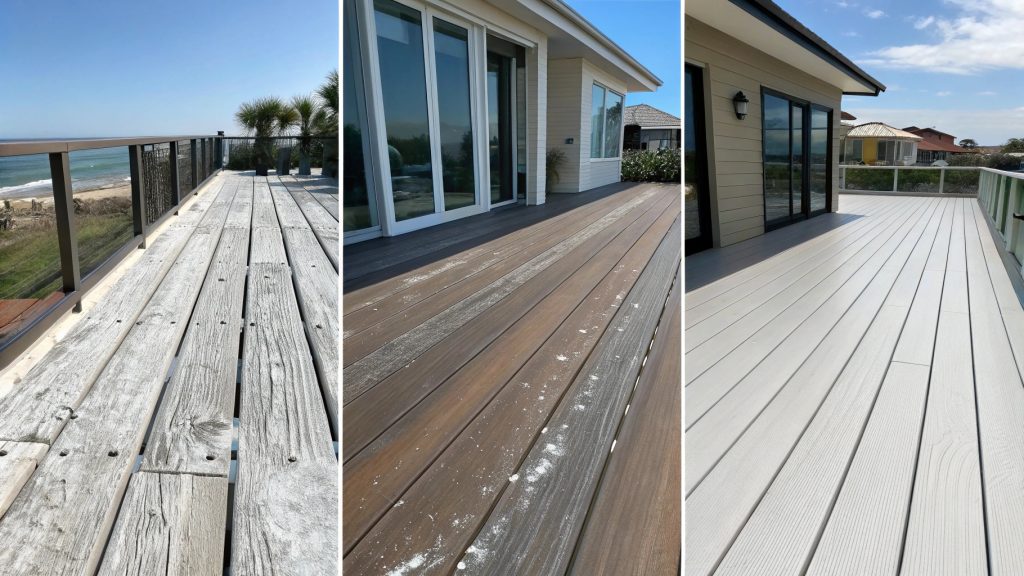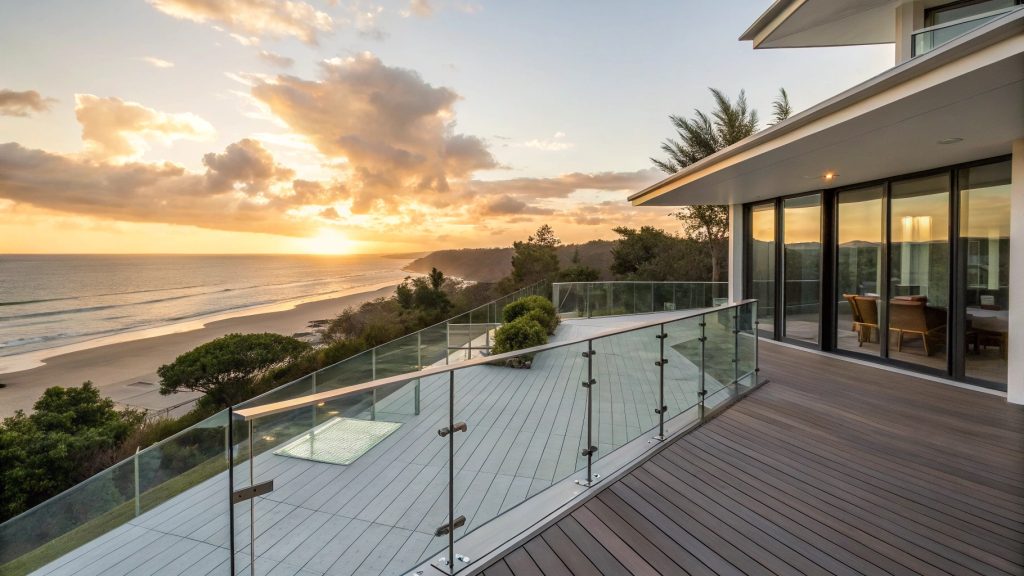Choosing between a multi-level and single-level deck is one of the biggest decisions homeowners face…
How Salt Air Affects Your Decking Choices: A Surfers Paradise Homeowner’s Complete Protection Guide

Choosing salt-air-resistant decking for your Surfers Paradise home involves understanding how coastal conditions affect different materials, protective treatments, and long-term maintenance requirements. Living metres from the Pacific Ocean means your deck faces unique environmental challenges that require specific material choices and protection strategies. This guide covers the science behind salt air corrosion, compares material performance in coastal conditions, explores protective coating options, and provides maintenance schedules specifically designed for Surfers Paradise’s unique climate.
Understanding Salt Air Corrosion on Coastal Properties
Salt air creates a corrosive environment that accelerates the deterioration of outdoor structures through a process called galvanic corrosion. When salt particles settle on decking materials, they attract moisture from the air, creating an electrolytic solution that breaks down metal fasteners, weakens timber fibres, and compromises protective coatings. This process occurs continuously in Surfers Paradise due to constant ocean breezes carrying salt particles inland, making material selection and protection strategies essential for deck longevity.
The Science Behind Salt Damage
Sodium chloride particles from ocean spray penetrate porous materials, such as timber, where they absorb atmospheric moisture and create concentrated salt solutions. These solutions accelerate oxidation in metal components and cause cellular breakdown in organic materials. Understanding this process helps explain why certain materials perform better in coastal environments and why regular maintenance becomes crucial for deck preservation.
Unique Challenges in Surfers Paradise
The beachfront location creates additional challenges beyond standard salt exposure, including high humidity levels, intense UV radiation, and seasonal weather patterns that cycle between dry and wet conditions. These factors work together to create an aggressive environment that necessitates specialised material choices and protective strategies.
Materials That Fight Salt Damage: A Technical Guide

Composite Decking Performance in Coastal Conditions
Composite decking materials offer superior resistance to salt air corrosion compared to traditional timber options. These engineered products combine recycled wood fibres with polymer resins, creating a non-porous surface that prevents salt penetration and moisture absorption. The polymer coating serves as a barrier against corrosive elements while preserving the aesthetic appeal of the natural wood grain. Composite materials require minimal maintenance in Surfers Paradise conditions and resist fading, staining, and structural degradation commonly associated with salt exposure.
Aluminum and Steel Decking Solutions
Marine-grade aluminium decking offers exceptional corrosion resistance through its natural oxide layer, which prevents salt damage. Powder-coated aluminium systems offer additional protection while maintaining structural integrity in coastal environments. Stainless steel components, particularly 316-grade stainless steel, demonstrate superior performance against salt corrosion due to their chromium and molybdenum content. These metal options require a careful selection of fasteners and hardware to prevent galvanic corrosion between dissimilar metals. For detailed technical information about metal performance in coastal environments, refer to Metal Construction News.
Treated Timber Options for Coastal Applications
When selecting timber for salt air environments, pressure-treated options using copper-based preservatives provide enhanced protection against moisture and salt damage. Hardwood species like spotted gum and ironbark naturally contain oils and densities that resist salt penetration better than softwood alternatives. However, even treated timber requires regular maintenance and protective coatings to maintain performance in Surfers Paradise conditions.
Protective Coatings and Treatments for Coastal Decks
Marine-Grade Sealers and Finishes
Marine-grade sealers provide essential protection against salt air penetration by creating a waterproof barrier on deck surfaces. These specialised coatings contain UV inhibitors and anti-corrosive additives specifically formulated for use in coastal environments. Penetrating sealers work by soaking into the material’s pores, while film-forming sealers create a surface barrier that prevents the infiltration of salt and moisture. Regular application of these protective coatings significantly extends deck life in Surfers Paradise conditions.
Anti-Corrosive Hardware Treatments
Deck hardware requires specialised treatment to prevent galvanic corrosion in environments with high salt content. Hot-dip galvanising offers superior protection for steel fasteners, whereas stainless steel hardware eliminates corrosion concerns. Protective coatings for existing hardware include zinc-rich primers and epoxy topcoats that create barriers against salt exposure. Proper hardware selection and treatment prevent structural failure and maintain deck safety over time.
Maintenance Schedules for Salt-Exposed Decking
Monthly Inspection and Cleaning Protocols
Regular maintenance begins with monthly visual inspections to identify early signs of salt damage, including white residue buildup, metal discolouration, and surface deterioration. Cleaning protocols involve gently washing with fresh water to remove salt deposits, followed by the application of a mild detergent for stubborn buildup. Avoid using high-pressure settings for pressure washing, as this can drive salt deeper into porous materials and damage protective coatings.
Seasonal Treatment Applications
Seasonal maintenance schedules are aligned with Surfers Paradise’s weather patterns, with major treatments applied during the dry months for optimal curing conditions. Spring applications focus on renewing protective coatings after winter weather exposure, while autumn treatments prepare decks for the increased humidity and storm seasons ahead. Timing these treatments correctly ensures maximum protection during peak periods of salt exposure.
Warning Signs: When Salt Damage Threatens Your Deck
Visual Indicators of Salt Corrosion
Early warning signs of salt damage include white crystalline deposits on surfaces, rust stains around fasteners, and discolouration of metal components. Timber may show signs of premature aging, including grey weathering, surface cracking, and soft spots where salt has penetrated. Regular monitoring of these indicators allows for preventive action before structural damage occurs.
Structural Concerns and Safety Issues
Advanced salt damage manifests as loose fasteners, sagging deck boards, and compromised structural connections. Metal components may show pitting corrosion or complete failure, while timber elements can develop rot or structural weakness. These conditions require an immediate professional assessment to ensure deck safety and prevent further deterioration.
When to Call Professional Help
Professional intervention becomes necessary when structural integrity is compromised, extensive metal corrosion is present, or protective coatings have failed across large areas. Qualified contractors can assess the severity of damage, recommend appropriate repairs, and implement comprehensive protection strategies. Early professional consultation prevents minor issues from becoming major structural problems.
Protecting Your Surfers Paradise Deck Investment
Making Informed Material Decisions
Selecting the right decking materials for your Surfers Paradise property requires balancing performance, aesthetics, and budget considerations within the unique coastal environment. Composite materials offer the best combination of salt resistance and low maintenance, while treated timber provides natural beauty when proper care protocols are followed. Metal options deliver maximum durability but require careful planning to prevent thermal expansion issues. Your choice should align with your long-term maintenance preferences and the specific exposure conditions of your property’s location. Professional deck construction services can help navigate these material choices effectively – learn more about deck construction in Surfers Paradise.

Long-Term Value and Property Enhancement
Investing in salt-air-resistant decking not only protects your property value but also enhances your outdoor living experience. Quality materials and proper maintenance prevent costly replacements and structural repairs that can arise from salt damage. A well-protected deck maintains its visual appeal and functionality, contributing to your home’s marketability and your family’s enjoyment of the coastal lifestyle in Surfers Paradise. The initial investment in appropriate materials and treatments pays dividends through reduced maintenance costs and extended deck life.
Taking Action to Protect Your Deck
Implementing a comprehensive protection strategy begins with assessing the current condition of your deck and identifying areas that require immediate attention. A professional consultation ensures that you select the appropriate materials and treatments for your specific situation. Regular maintenance schedules, combined with quality protective products, create a systematic approach to deck preservation that maximises your investment while minimising ongoing concerns about salt air damage. For compliance with local building requirements, refer to Queensland’s building laws and standards.
